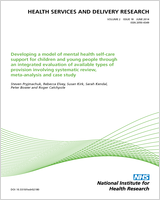Included under terms of UK Non-commercial Government License.
NCBI Bookshelf. A service of the National Library of Medicine, National Institutes of Health.
Galdas P, Darwin Z, Fell J, et al. A systematic review and metaethnography to identify how effective, cost-effective, accessible and acceptable self-management support interventions are for men with long-term conditions (SELF-MAN). Southampton (UK): NIHR Journals Library; 2015 Aug. (Health Services and Delivery Research, No. 3.34.)

A systematic review and metaethnography to identify how effective, cost-effective, accessible and acceptable self-management support interventions are for men with long-term conditions (SELF-MAN).
Show detailsTABLE 42
Critical Appraisal Skills Programme criteria
| CASP item | Criteria used |
|---|---|
| 1. Was there a clear statement of the aims of the research? | Aim can be determined from anywhere in the paper (e.g. title, abstract, introduction, methods) |
| 2. Is a qualitative methodology appropriate? | Qualitative research is the appropriate way to address the aim or answer the research question (e.g. the research concerns experiences/views of participants, processes involved, or the nature of interactions) |
| 3. Was the research design appropriate to address the aims of the research? | Data collection, data analysis and methodological approach are appropriate to address the aim or answer the research question; the review team classified methodological approach based on whether the approach had consistently been used throughout (e.g. grounded theory required analytical methods such as constant comparison as well as the development of a core category or theory) |
| 4. Was the recruitment strategy appropriate to the aims of the research? | Authors clearly report selection of participants and this is appropriate to address the aim or answer the research question. Additional prompt:
|
| 5. Was the data collected in a way that addressed the research issue? | Type of data collection method is clear (e.g. interview, focus group, participant observation, online postings) and has potential to address the aim or research question. Additional prompt:
|
| 6. Has the relationship between researcher and participants been adequately considered? | Authors demonstrate self-reflexivity in data collection and data analysis processes |
| 7. Have ethical issues been taken into consideration? | Approval from an ethics committee is reported |
| 8. Was the data analysis sufficiently rigorous? | Authors clearly describe data analysis approach and employ strategies to ensure rigour (e.g. peer debriefing, member checking, negative cases). Additional prompts:
|
| 9. Is there a clear statement of findings? | Findings are clearly stated (e.g. in the abstract or findings) |
| 10. Is the research valuable? | Study appears valuable in own right (i.e. something has been ‘learnt’), rather than judged in relation to contribution made to the current review. Additional prompts:
|
Note
The main 10 items were scored ‘yes’, ‘no’ or ‘unclear’ whereas the additional prompts were used to facilitate summarising the main strengths, limitations and concerns of each study.
Source: CASP Qualitative Checklist.281 URL: www.casp-uk.net/#!casp-tools-checklists/c18f8 (accessed 3 September 2013).
- Critical Appraisal Skills Programme criteria - A systematic review and metaethno...Critical Appraisal Skills Programme criteria - A systematic review and metaethnography to identify how effective, cost-effective, accessible and acceptable self-management support interventions are for men with long-term conditions (SELF-MAN)
Your browsing activity is empty.
Activity recording is turned off.
See more...